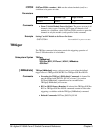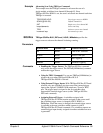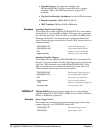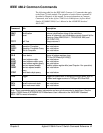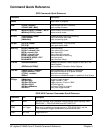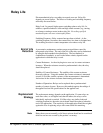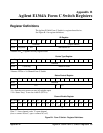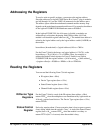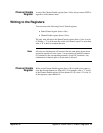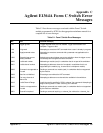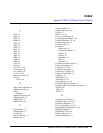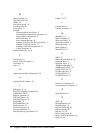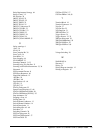
Addressing the Registers
To read or write to specific registers, you must use the register address.
Since the addresses for Agilent 75000 Series B or Series C plug-in modules
are A00 through A15, use the VME A16 mnemonic for the address space.
The address space within the mainframe/command module memory map
depends on the mainframe/command module used. For example, the address
of the Agilent E1300B/E1301B Mainframe starts at lF0000
16
.
In the Agilent E1300/E1301, the A16 space is divided so modules are
addressed only at locations beginning with C000
16
within A16. Each
module is allocated 64 register addresses (40
16
). The module base address is
related to the logical address set by the logical address switch (LADDR) on
the module:
base address (hexadecimal) = (logical address
16
)*40
16
+ C000
16
For the Form C Switch, the factory-set logical address is 120 (78), so the
base address = (78
16
)*(40
16
) + C
16
= DE00
16
. Then, for example, to
address the Status/Control register of a Form C Switch in an Agilent
E1300B/E1301B, the register address = [A16 location]
16
+ [base address]
16
+ [register offset]
16
= lF0000
16
+ DE00
16
+ 04
16
= lFDE04
16.
Reading the Registers
You can read the following Form C Switch registers:
• ID register (base + 00
16
)
• Device Type register (base + 02
16
)
• Status/Control register (base + 04
16
)
• Channel Enable register (base + 08
16
)
ID/Device Type
Registers
For the Form C Switch, a read of the ID register (base address + 00
16
)
returns FFFF
16
since the multiplexers are manufactured by Agilent and are
A16 only, register-based devices. The Device Type register (base + 02
16
)
returns FF20
16
.
Status/Control
Register
Each relay requires about 15 msec execution time (close to open or open to
close) during which time the switch is "busy". A read of the Status/Control
register (base + 04
16
) returns FFFF
16
when the module is not busy or
returns FF7F
16
(bit 7 is low-true) when the module is busy.
66 Agilent E1364A Form C Switch Registers Appendix B



